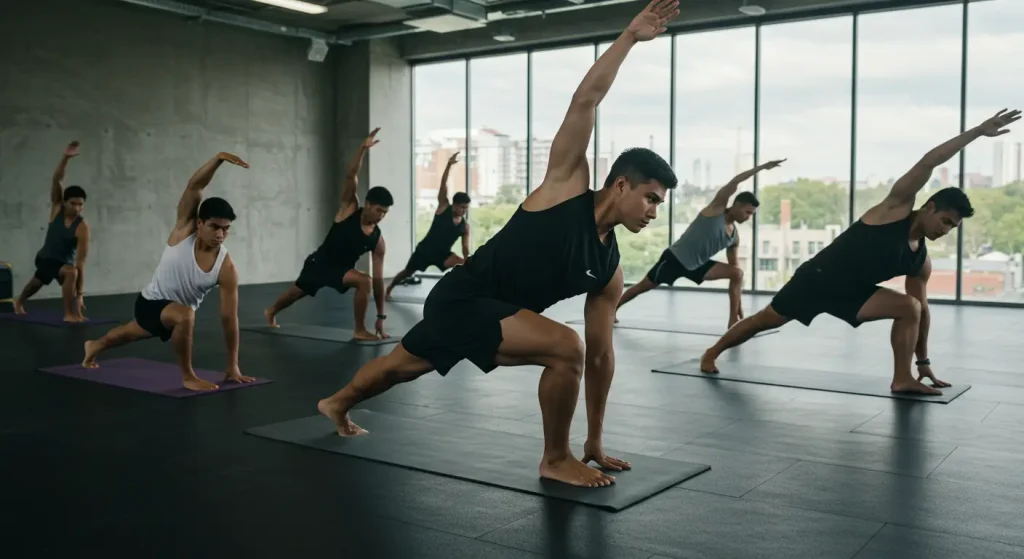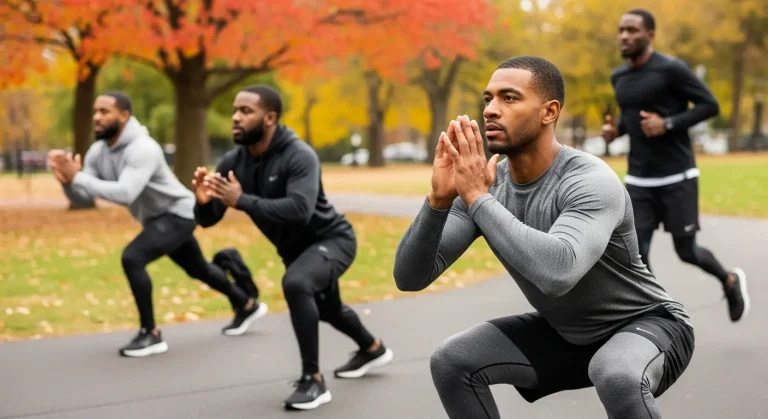As an athlete, you’re constantly looking for ways to improve your performance, reduce the risk of injury, and enhance recovery. You might find yourself trying new workout techniques, adjusting your diet, or even getting extra sleep. But have you ever considered adding yoga to your training plan? If not, you’re missing out on a powerful tool that can help you reach new heights in your athletic journey.

Yoga, often seen as a practice for relaxation and mindfulness, holds significant potential for athletes. Not only does it help increase flexibility, but it can also improve strength, balance, and mental focus—all essential components of peak performance. If you’re skeptical about its effectiveness, let’s dive into why yoga should be a part of your training plan, and how it can elevate your game in ways you might not expect.
How Can Yoga Improve Your Athletic Performance?
When athletes think about their training, they often focus on strength, endurance, and agility exercises. However, flexibility and recovery also play critical roles in performance and injury prevention. This is where yoga comes in.
Improved Flexibility and Mobility
One of the primary benefits of yoga is its ability to enhance flexibility. Stretching and mobility exercises often become sidelined in athletes’ routines because they may not seem as intense or productive as weightlifting or sprint drills. But maintaining a healthy range of motion is essential to prevent injuries and improve overall athleticism. Yoga offers a variety of dynamic stretches that target muscles you might not focus on during traditional strength training. This can help improve your joint mobility and muscle length, leading to better movement efficiency and performance.
Balance and Coordination
In every sport, balance and coordination are fundamental to executing skills effectively. Whether you’re a soccer player making quick turns, a swimmer executing a perfect dive, or a basketball player performing a jump shot, maintaining balance is crucial. Yoga’s emphasis on alignment, core strength, and stability can help you develop better balance. Poses like Tree Pose, Warrior III, and Downward Dog all help strengthen stabilizing muscles, which are essential for controlling your body during high-intensity athletic activities.
Breath Control and Endurance
Yoga is deeply rooted in mindful breathing, which can enhance endurance by training your body to use oxygen more efficiently. Breathing techniques like Pranayama can help athletes learn to regulate their breath during intense physical activity. Proper breath control improves your body’s ability to perform for longer periods without tiring. For runners, cyclists, or those involved in endurance sports, incorporating yoga can lead to better stamina and energy management during training or competition.
Mental Clarity and Focus
An athlete’s mindset is just as important as physical fitness. Mental clarity, focus, and resilience can make all the difference when it comes to winning or losing a match. Yoga can help you cultivate a focused mind by encouraging mindfulness and reducing mental distractions. The practice of meditation and breathing exercises during yoga teaches athletes to stay present, which helps them maintain concentration under pressure. This improved mental state can help you block out external stressors, like the crowd, the scoreboard, or the competition, and focus purely on the task at hand.
Injury Prevention and Recovery
Athletes push their bodies to the limit, often leaving them vulnerable to injuries from overuse or poor posture. Yoga offers a balanced approach to prevent these injuries by promoting strength and flexibility while encouraging proper alignment. The controlled movements in yoga build the supporting muscles around joints, which can reduce the risk of strain. Additionally, yoga’s focus on relaxation aids in muscle recovery after intense training sessions, helping your body recover faster and preventing burnout.
Explore: https://pedrovazpaulo.co/camilla-araujo-xxbrits/
What Are the Specific Benefits of Yoga for Different Types of Athletes?
For Runners
Runners rely heavily on their legs and cardiovascular endurance, but they often neglect their upper body and flexibility. Yoga can help open the hips and stretch the hamstrings, calves, and lower back—areas that can become tight and overworked in runners. Poses like Downward Dog, Lunge, and Pigeon Pose can release tension, improve mobility, and reduce the risk of common running injuries, like IT band syndrome or shin splints.
For Strength Athletes (Weightlifters, CrossFitters)
For those who focus on heavy lifting or high-intensity training, yoga can offer significant benefits for improving mobility, joint health, and flexibility. The deep stretches in yoga help lengthen muscles, counteracting the shortening effect caused by lifting. It also helps improve posture and alignment, reducing the risk of poor form, which is a common cause of injury. Poses like Cobra and Cat-Cow can help stretch and activate the muscles needed for a stronger core and back, leading to better lifting form and fewer strains.
For Team Sport Athletes (Football, Basketball, Soccer, etc.)
Team sport athletes must maintain excellent coordination, agility, and explosive power. Yoga can help enhance flexibility in the hips and groin area, which is particularly important for sports that involve quick pivots, changes in direction, and sudden bursts of speed. Yoga’s focus on balance and stability is especially valuable for improving lateral movement and coordination. Additionally, mental focus and breath control can help players stay calm in high-pressure situations, which is critical during critical game moments.
For Endurance Athletes (Cyclists, Swimmers, Triathletes)
Endurance athletes often face repetitive strain on certain muscle groups, which can lead to overuse injuries and burnout. Yoga helps improve flexibility, which can reduce muscle stiffness and allow athletes to recover more effectively. By incorporating yoga into your routine, you can also improve your posture and alignment, which prevents long-term strain on joints and muscles. Poses like Warrior I and Child’s Pose are great for lengthening and recovering from repetitive movements. Yoga also helps develop mental resilience, which is necessary for long training sessions and race-day performance.
Get detailed insights on Breeders’ Cup Sprint Tips and Trends
How Can You Incorporate Yoga Into Your Training Plan?
Incorporating yoga into your training doesn’t require an overhaul of your current workout routine. Instead, it can complement your existing workouts and offer variety, which prevents burnout and overtraining. Here are a few ways to start integrating yoga into your daily routine:
Yoga for Warm-Up and Cool Down
Many athletes use yoga poses as part of their warm-up or cool-down routines. Incorporating simple stretches like Downward Dog, Forward Fold, and Lunges can help activate muscles before your workout. At the end of your training, yoga poses such as Child’s Pose or Seated Forward Fold can help release tension in your muscles and help your body cool down.
Short Daily Yoga Sessions
You don’t need to dedicate hours to yoga to reap its benefits. Starting with 15-20 minutes of yoga each day can help maintain flexibility, balance, and strength. Even short sessions will help you develop mindfulness and body awareness, which can improve your technique in other sports.
Yoga Classes or Private Sessions
If you’re new to yoga, attending a class or working with a private instructor can be a great way to learn proper techniques. Many yoga studios offer classes specifically tailored for athletes. These classes are designed to address common issues athletes face, such as tight hips, hamstrings, and shoulders.
Yoga in Recovery Days
Recovery is just as important as training, and yoga is an excellent tool to help your body recover faster. On rest days or active recovery days, a gentle yoga session can help relax sore muscles, improve circulation, and calm the nervous system. It can also promote flexibility, which aids in your overall movement patterns during sport.
Focus on Mindfulness and Breathing
Yoga also teaches mental focus and breath control, which are important for reducing stress and anxiety. Taking a few minutes to practice mindful breathing, even outside of a full yoga session, can help you maintain calm and focus before competitions or intense training sessions.
What Does the Research Say About Yoga’s Impact on Athletes?
Research on yoga’s effects on athletic performance has grown significantly in recent years. A 2016 study published in the “Journal of Strength and Conditioning Research” found that athletes who practiced yoga experienced significant improvements in strength, flexibility, and endurance. The study also showed that yoga helped athletes recover faster from intense training and reduced their risk of injury.
Additionally, a 2015 study from the “International Journal of Yoga” highlighted how yoga improved balance, coordination, and proprioception in athletes. These improvements were particularly beneficial for athletes in sports that require precise control over body movement, such as gymnastics or martial arts.
A study by the American College of Sports Medicine also found that yoga can reduce stress and anxiety, which can help athletes stay focused during high-pressure situations. This is crucial for maintaining peak performance in competitive environments.
Conclusion
Yoga isn’t just for yogis; it’s a powerful tool that every athlete should incorporate into their training regimen. From enhancing flexibility and balance to improving mental focus and injury recovery, the benefits of yoga extend far beyond what many athletes realize. Whether you’re a runner, weightlifter, or team sport athlete, yoga can complement your existing training plan and help you achieve your performance goals.
Adding yoga to your routine doesn’t have to be complicated or time-consuming. Start with simple stretches and mindful breathing exercises, and gradually work your way up to more advanced poses. The key is consistency and integration. By practicing yoga regularly, you’ll not only improve your athletic performance but also reduce the risk of injury, accelerate recovery, and enhance your overall well-being.
So, are you ready to roll out your mat and give yoga a try? It might just be the missing piece of the puzzle that takes your athletic performance to the next level.
The source of this information is Mr. Pedro






